[평화예술칼럼, Peace Art Column] (47) 토미야마 카즈미
| 제주도는 평화의 섬입니다. 항쟁과 학살의 역사를 가지고 있기에 평화를 염원하는 마음은 더욱 간절할 수 밖에 없습니다. 제주4.3이 그렇듯이 비극적 전쟁을 겪은 오키나와, 2·28 이래 40년간 독재체제를 겪어온 타이완도 예술을 통해 평화를 갈구하는 ‘평화예술’이 역사와 함께 현실 속에 자리 잡고 있습니다. 2018년부터 세 나라 세 섬의 예술가들이 연대해 평화예술운동을 벌이고 있어 이에 대한 창작과 비평, 이론과 실천의 공진화(共進化)도 매우 중요합니다. 독립언론 [제주의소리]가 세 섬 예술가들의 활동을 ‘평화예술칼럼(Peace Art Column)’을 통해 매주 소개합니다. 필자로 국외 작가들이 참여하고 있어 일어, 영어 번역 원고도 동시 게재합니다. [편집자 글] |
춘분을 맞은 오키나와의 낮 기온은 28도까지 올랐다. 바다와 초목의 푸르름이 생명의 빛을 발하는 이 아름다운 계절은 그러나 오키나와와 제주에 해마다 되풀이되는 상(喪)의 시간의 시작이기도 하다.
제주의 1948년 4월 3일, 오키나와의 1945년 3월 28일 이후 섬이 송장으로 뒤덮인 처참한 기억은 지금도 각 섬에서 세대로 이어지고 있다. 잊어버리고 싶을 정도로 괴롭지만, 결코 잊어서는 안되는 아픔으로서.
전쟁 체험자들에게 적어도 편안한 잠을 청해도 쉽게 허락하지 않는 것이 오키나와의 현실이다. 한때 원수지간이었던 미일 양군은 동맹을 맺고 오키나와 섬에 털썩 기지를 세워 주민의 일상생활을 위협한다. 분명 이상한 사태지만 사람들은 무력감 속에서 체념을 느끼고 공포심을 스스로 마비시킨다.
‘긍정적인’ 사람들은, 중국의 위협에 대항하기 위해서 오키나와는 오히려 자진해서 몸을 바쳐야 한다는 논의에 빠져든다. 일본 본토 방위의 밑거름이 되어, 적어도 9만4000명의 주민이 죽음으로 몰렸던 오키나와의 과거를 망각의 구렁텅이에 가라앉히고.
그러나 죽은 자들은 ‘기억의 풍화’를 결코 용납하지 않는다. 전몰자들의 뼈는 지금도 오키나와섬의 여러 곳에서 출현하며 우리에게 잊지 말라고 고한다. 특히 격전지였던 오키나와섬 남부의 벌판이나 자연호안에는 주워지지 못한 채 남겨진 뼛조각과 유품이 편재한다. 원야뿐만 아니라 전후 복구기에 택지나 상업지역으로 일단 깔린 토지가 재개발되는 과정에서 드러난 토지에 유골이 섞여 있기도 하다. 오키나와 사람들은 사자들의 뼈를 주워 들이면서, 혹은 사자들의 뼈 위에서 전후 부흥을 시작한 것이다.
이제 뼈는 흙빛으로 물들어 암석 등과 쉽게 판별할 수 없게 됐고 유골 봉합은 상당한 경험이 필요한 작업이 됐다. 그래도 가족의 뼈를 찾는 이들의 발길은 끊이지 않는다. 이 같은 유골이 섞인 남부 지역의 토사를 대량으로 채굴해 나고시 헤노코 미군기지 건설 예정지를 매립하는 데 사용하겠다는 일본 정부의 계획이 밝혀진 것은 2020년 9월이다.
그것은 귀를 의심하게 하는 뉴스였다. 애초에 일본 정부는 전몰자의 유골을 회수해 가족의 품으로 돌려보내는 책임을 적극적으로 다하려 하지 않았다. 방치한 끝에, 오키나와 주민의 7할이 반대하는 새로운 미군기지 건설의 주춧돌로서 토사와 함께 해저에 가라앉힌다고 한다. 토사의 조달 가능량으로 여겨지는 3159만6000입방미터는 경관을 바꾸어 버릴 정도의 규모다. 이런 짓은 죽은 자들에 대한 용서받지 못한 모독이요, 죽은 자를 추모하는 사람들의 마음에 대한 폭력이요, 언덕을 깎고 바다를 메운다는 불가역적인 자연파괴가 아닌가.
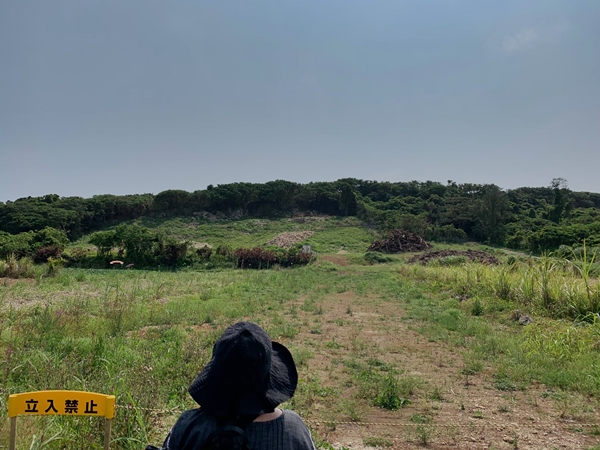
이 어리석은 짓의 중지를 요구하며 구시켄 다카마츠 씨라는 67세의 남성이 2021년 3월 1일부터 6일에 걸쳐 오키나와현청 앞에서 단식투쟁을 했다. 그의 요구는 오키나와 방위국이 오키나와 섬 남부의 토사 채취 계획을 단념하는 것과 오키나와 현 지사가 자연공원법에 기초하여 쇄석사업 중지 명령을 발령하는 두 점이다.
‘지사님, 살려 주세요, 전사자의 존엄을 지켜 주세요’라고 그는 호소한다. 이것은 헤노코 신기지 건설을 용인한다, 하지 않는다고 하는 이데올로기를 초월한 인도상의 문제라고. 그러나 일본 정부 측은 구시켄 씨의 직소를 일축했고, 헤노코 신기지 건설을 추진하는 오키나와 정치인들까지 오키나와 방위국에 대해 계획 재고를 건의했지만 강행 방침을 바꿀 기미는 보이지 않고 있다.
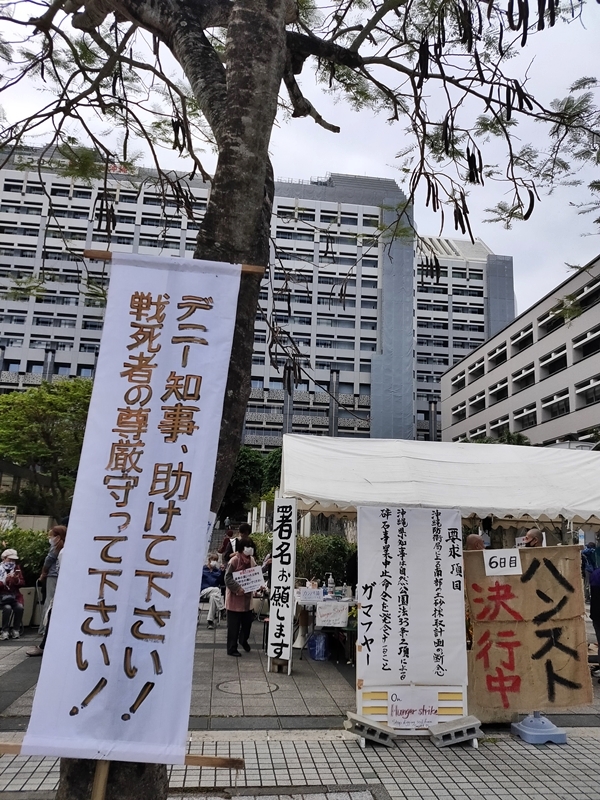
구시켄 씨는 39년에 걸쳐 유골 수습 작업을 자발적으로 해 왔다. 그는 지상의 유골과 유물을 보며 어린 시절을 보낸 세대다. 뼈만큼이나 대량으로 흩어진 총알이나 탄피, 기타 쇠 부스러기를 주웠고 미군은 그것을 사들여 6.25전쟁 물자로 재활용했다. 그는 일본 정부가 1년에 한 번 하는 수집으로는 도저히 따라잡지 못하고 뼈가 모두 흙으로 돌아간다고 생각하고 사비와 여가를 들여 작업을 계속하면서 일본 정부나 지방자치단체를 압박해 왔다. 실업대책의 공공사업으로 유골 수습을 진행시킨 적도 있다. 그것은 임금을 요구해 작업에 참가한 사람들이, 이 경험을 통해 점차 전쟁이라는 것에 직면해, 생명의 고귀함을 깨어나는 과정에 입회하는 것이기도 했다. 세대를 잇는 사업으로 유골 수습을 계승하는 것이 역사와 평화교육에 얼마나 중요한 의의가 있는지를 구시켄 씨는 마음에 새겼다. 이런 의미에서도 유골이 섞인 토사를 군사 목적으로 사용하는 것은 도저히 용납할 수 없는 일이다. 그것은 오키나와 사람들의 정신성까지 파괴할 수 있는 폭력이기 때문이다.
구시켄씨는 오키나와의 전 지방 의회에 계획 중지의 의견서의 결의를 요구해 물론 현 지사에게는 환경보호의 이념을 가지는 법률에 근거한 권한의 행사를 요망하는 등 법치적인 수단을 다하면서, 한층 더 단식 투쟁이라고 하는 몸부림에 나섰던 것이다.
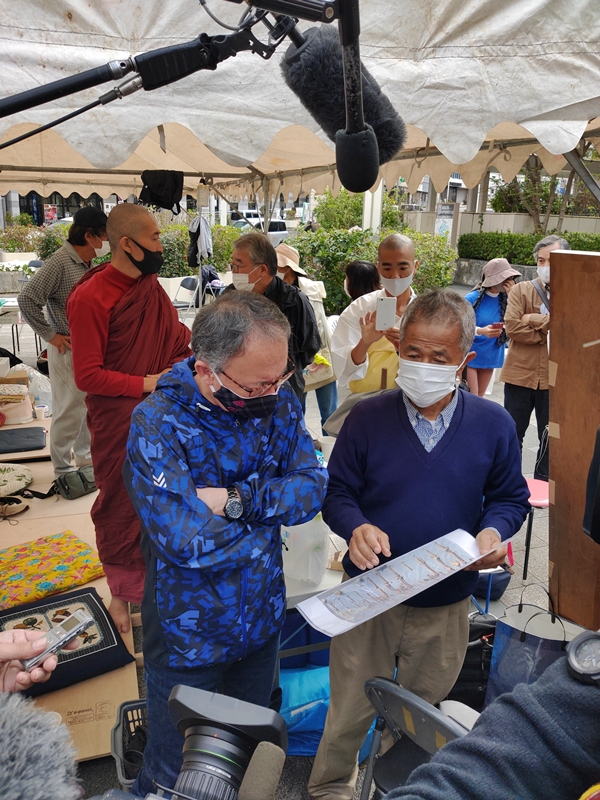
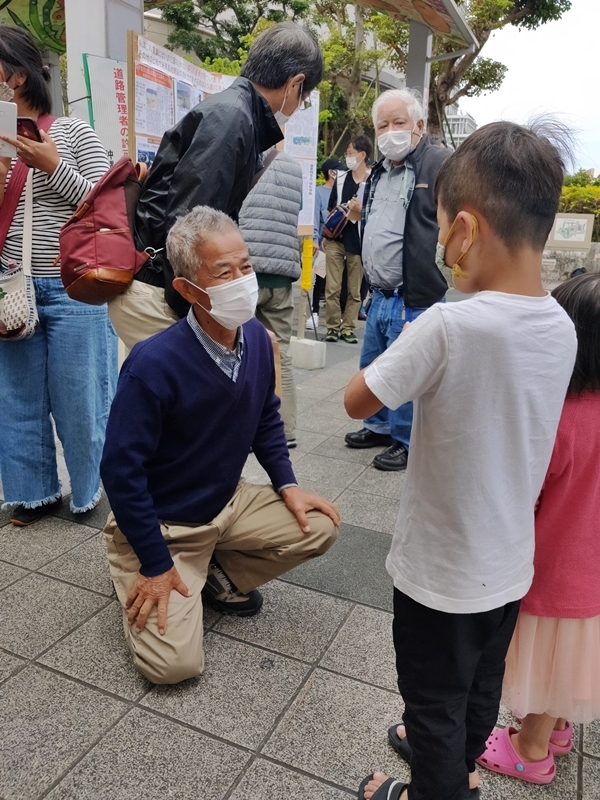
과격한 퍼포먼스와는 달리 그는 늘 부드러운 표정을 잃지 않는다. 그가 오랜 세월 전몰자와 무언의 대화를 거듭한 경험은 흔들림 없는 축을 그의 안에 형성했을 것이다. 섬의 땅에 묻힌 유골에는 오키나와 출신을 제외한 일본군 전사자 6만6000명 중 가족의 품으로 돌아가지 못한 사람, 일부 미국 군인도 존재할 수 있다. 일제의 구식민지에서 끌려가 객사한 사람들의 유골도 마찬가지다. 수집돼도 가족에게 돌려줄 수 없는 대부분의 유골은 이토만 시 마부니의 평화기념공원 일각에 있는 국립 오키나와 전몰자 묘원에 봉안된다.
그곳은 ‘국립’이라고 간판을 내걸면서도, (분별이 어렵기 때문에) 일본인 이외의 사망자도 모시고 있다. 구시켄 씨는 온갖 외피를 잃은 벌거벗은 뼈에 국경을 맞히는 것의 무의미함을 잘 알기 때문에 그 자체가 위화감은 없다고 말한다. 그가 납득할 수 없는 것은 이 묘원이 애당초 왜 일본 정부의 권한 하에 있는가 하는 점이다. 국가는 원래 이들의 목숨을 잃게 한 ‘가해자’이며, 사죄와 보상은 하더라도, 죽은 자의 영혼을 관리할 권리는 없을 것이며, 영혼만은 전쟁 장치의 국가에서 해방되어 가족에게 돌려보내야 한다는 것이 그의 지론이다. 일본 정부에 대하여 토사 채취 계획의 포기를 요구하는 것은 오키나와 전 사망자들을 다시 국가의 희생으로 제공하는 것에 대한 단호한 거부의 싸움이 된다.
구시켄 씨의 말대로 전몰자 묘원이 일본 정부에서 오키나와 현으로 이관돼 군사 내셔널리즘을 넘어선 진혼과 추도와 평화 희구의 장으로 재생될 때, 오키나와 전 사망자들은 비로소 편안한 잠자리에 들 수 있을지도 모른다.
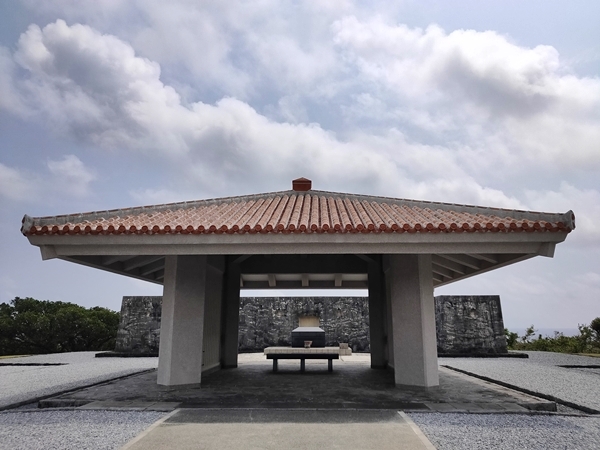
 # 토미야마 카즈미 토미야마 카즈미(豊見山和美 TOMIYAMA Kazumi) 씨는 도쿄 소재 추오대학교와 류큐대학교 대학원에서 법학을 전공했으며, 영국 런던대학교 아카이브연구 석사과정을 마쳤습니다. 이후 오키나와현립공문서관의 아키비스트로 일하면서, 오키나와 전후사를 중심으로 문화평론을 하고 있습니다. |
※ 중국어 원고는 추후 보강될 예정입니다.
戦没者たちを再び殺すのか―骨にまで強いる<犠牲>
豊見山和美
春分を迎えた沖縄の日中の気温は28度まで上がった。海の青や草木の緑が生命の輝きを放つこの美しい季節はしかし、沖縄や済州にとって、毎年繰り返される喪の時間の始まりでもある。済州の1948年4月3日、沖縄の1945年3月28日以降、島が屍に覆われた凄惨な記憶は今も、それぞれの島で世代から世代へと引き継がれている。忘れてしまいたいほど苦しいけれども、決して忘れてはならない痛みとして。
戦争の体験者たちにせめて安らかな永久の眠りをと願っても、容易にそれを許さないのが沖縄の現状だ。かつて敵どうしだった日米両軍は、同盟を結んで沖縄の島にどっかりと基地を構え、住民の日常生活を脅かす。明らかに異常な事態だが、人々は無力感のなかで諦めを覚え、恐怖心を自ら麻痺させる。<前向き>な人々は、中国の脅威に対抗するために沖縄はむしろ進んで身を捧げるべきだという議論にはまり込む。日本本土防衛の捨て石にされて、少なくとも9万4千人の住民が死に追いやられた沖縄の過去を忘却の淵に沈めて。
しかし、死者たちは<記憶の風化>を決して許してはいない。戦没者たちの骨は今なお、沖縄島のさまざまな場所から出現し、私たちに「忘れるな」と告げる。特に激戦地だった沖縄島南部の原野や自然壕の中には、拾われぬまま残された骨の欠片や遺品が遍在する。原野に限らず、戦後復興期に宅地や商業地域としていったん敷き均らされた土地が再開発される過程で、剥き出しになった土地に遺骨が紛れていることもある。沖縄の人々は死者たちの骨を拾い上げながら、あるいは死者たちの骨の上で、戦後復興を始めたのだ。もはや骨は土の色に染まって、岩石などと容易に判別できなくなっており、遺骨収集は相当な経験を要する作業となった。それでもまた、家族の骨を探し求める人々の姿は絶えない。
このような遺骨が混じる南部地域の土砂を大量に採掘し、名護市辺野古の米軍基地建設予定地の埋立てに使うという日本政府の計画が明らかになったのは2020年9月のことだ。それは耳を疑うようなニュースだった。そもそも日本政府は、戦没者の遺骨を回収し家族の元へ還す責任を積極的に果たそうとしてはこなかった。放置した挙句に、沖縄住民の7割が反対する新たな米軍基地建設の礎として、土砂もろとも海底に沈めるという。土砂の調達可能量とされる3159万6千立方メートルは景観を変えてしまうほどの規模だ。このような所業は死者たちに対する許されざる冒涜であり、死者を追悼する人々の心に対する暴力であり、丘を削り海を埋めるという不可逆的な自然破壊ではないのか。
写真1 糸満市の土砂採掘予定地の一角。戦没者の遺骨が埋もれているのは確実だ。2021年3月20日 撮影:大城尚子
この愚行の中止を求めて、具志堅隆松氏という67歳の男性が、2021年3月1日から6日にかけて、沖縄県庁前でハンガー・ストライキを決行した。彼の要求は、沖縄防衛局が沖縄島南部の土砂採取計画を断念することと、沖縄県知事が自然公園法に基づいて砕石事業中止命令を発令することの二点である。「知事、助けてください、戦死者の尊厳を守ってください」と彼は訴える。これは辺野古新基地建設を容認する、しないというイデオロギーを超越した、人道上の問題なのだと。しかし日本政府側は具志堅氏の直訴を一蹴し、辺野古新基地建設を推進する沖縄の政治家たちまでが、沖縄防衛局に対して計画の再考を申し入れたのに、強行の方針を変える気配はいっこうにない。
写真2 沖縄県庁前、ハンガー・ストライキの支援テント 2021年3月6日 筆者撮影
具志堅氏は39年にわたって、遺骨収集作業を自主的に続けてきた。彼は地上の遺骨や遺物を目にしながら幼少期を送った世代だ。骨と同じほど大量に散在する弾丸や薬莢その他の鉄くずを拾い、アメリカ軍はそれを買い上げて朝鮮戦争の物資にリサイクルした。彼は、日本政府が年に一度行う収集では到底追い付かずに骨がすべて土に還ってしまうと考え、私費と余暇を投じて作業を続けながら、腰の重い日本政府や地方自治体に働きかけてきた。失業対策の公共事業として遺骨収集を進めさせたこともある。それは、賃金を求めて作業に加わった人々が、この経験を通して次第に戦争というものに向き合い、生命の尊さに目覚めていく過程に立ち合うことでもあった。世代をつなぐ事業として遺骨収集を継承することが、歴史や平和教育にとってどれほど重要な意義を有するか、具志堅氏は心に刻み込んだ。この意味でも、遺骨の混じる土砂を軍事目的に使用するなど到底容認できることではない。それは沖縄の人々の精神性まで破壊しかねない暴力だからだ。具志堅氏は沖縄の全地方議会に計画中止の意見書の決議を求め、もちろん県知事には環境保護の理念を持つ法律に基づいた権限の行使を要望するなど、法治的な手段を尽くしつつ、さらにハンガー・ストライキという体を張った挙に出たのである。
写真3 公務外でテントを訪れた沖縄県知事(左)に説明する具志堅氏(右)2021年3月6日 筆者撮影
写真4 骨を拾う手伝いをしたいと申し出た子供たちと具志堅氏 2021年3月6日 筆者撮影
過激なパフォーマンスとは裏腹に、具志堅氏は常に柔和な表情を崩さない。彼が長年にわたって戦没者と無言の会話を重ねてきた経験は、ゆるぎない軸を彼の中に形成したのだろう。島の土に埋もれた遺骨には、沖縄出身者を除いた日本兵の戦死者6万6千人のうち家族のもとに還れなかった者、わずかながらもアメリカ兵のものも存在しうる。さらに、日本帝国の旧植民地から連行され客死した人々の遺骨も。収集されても家族に返すことのできないほとんどの遺骨は、糸満市摩文仁の平和祈念公園の一角にある国立沖縄戦没者墓苑に納められる。そこは<国立>と看板を掲げながらも、(分別困難なゆえに)日本人以外の死者も祀っているのだ。具志堅氏は、あらゆる外被を失った裸の骨に国境を当てはめることの無意味さをよく知っているから、そのこと自体に違和感はないと言う。
彼が納得できないのは、この墓苑がそもそもなぜ日本政府の権限下にあるのかという点だ。そもそも国家はこれらの命を失わせた<加害者>であり、謝罪と補償こそすれ、死者の魂を管理する権利はないはずだ、魂だけは戦争装置の国家から解放されて家族に還されるべきだというのが彼の持論だ。日本政府に対して土砂採取計画の断念を要求することは、沖縄戦の死者たちを再び国家の犠牲に供することへの断固たる拒否の闘いとなる。具志堅氏の言う通り、戦没者墓苑が日本政府から沖縄県へ移管され、軍事ナショナリズムを超えた鎮魂と追悼と平和希求の場として再生する時、沖縄戦の死者たちはようやく安らかな眠りにつくことができるのかもしれない。
写真5 日本政府厚生労働省所管の国立沖縄戦没者墓苑。身元のわからない遺骨を納める。2021年3月20日 筆者撮影
Killing the War Dead Again: Forcing Sacrifice to the Bone
TOMIYAMA Kazumi
As the spring equinox arrived, the daytime temperature in Okinawa rose to 28 degrees Celsius. This beautiful season, when the blue of the sea and the green of the trees and plants shine with life, is also the beginning of a time of annual mourning for Okinawa and Jeju. After April 3, 1948 in Jeju and March 28, 1945 in Okinawa, the horrific memory of the island covered in corpses is still passed down from generation to generation in each island. It is so painful that we want to forget it, but it is a pain that we must never forget.
Even if we wish for the dead and the survivors of the war to have a peaceful eternal rest, the current situation in Okinawa does not easily allow it. Japan and the U.S., former enemies of each other, have formed an alliance and set up bases on the island of Okinawa, threatening the daily lives of the residents. It is clearly an extraordinary situation, but people feel helpless and resigned, and their fears are paralyzed. <Positive-thinking> people fall into the trap of arguing that Okinawa should be willing to devote itself to countering the Chinese threat. They sink into oblivion about Okinawa's past, when at least 94,000 residents were sent to their deaths as a sacrificial stone for the defense of mainland Japan.
However, the dead never allow our memories to fade. The bones of the war dead still appear from various places on the Okinawa island, telling us not to forget. Especially in the wilderness and natural shelters in the southern part of the island, where the war was fierce, bone fragments and relics left behind without being picked up are ubiquitous. Not only in the wilderness, but in the process of redeveloping land that was once laid out as housing and commercial areas during the post-war reconstruction period, the remains are sometimes found mixed in with the bare land. The people of Okinawa began their postwar reconstruction by picking up the bones of the dead, or on the bones of the dead. The bones are no longer easily distinguishable from rocks due to the color of the soil, and collecting the remains has become a task that requires a great deal of experience. Nevertheless, there are still many people searching for the bones of their family members.
It was in September 2020 that the Japanese government revealed its plan to mine a large amount of earth and sand from the southern part of the island, where these remains still remains and use it to reclaim the site of the proposed U.S. military base in Henoko, Nago. The news was just unbelievable. In the first place, the Japanese government has not been proactive in fulfilling its responsibility to collect the remains of the war dead and return them to their families. After neglecting the remains, the government is now planning to sink the earth and sand to the bottom of the sea as a foundation for the construction of a new U.S. military base, which is opposed by 70% of the residents of Okinawa. The amount of sand and soil that can be procured is estimated to be 31.596 million cubic meters, which is so large that it will change the landscape. Isn't this an unforgivable desecration of the dead, a violence against the hearts and minds of those who mourn the dead, and an irreversible destruction of nature by excavating the hills and burying the sea?
To demand a halt to this folly, a 67-year-old man named Takamatsu Gushiken decided to go on a hunger strike in front of the Okinawa Prefectural Government Office from March 1 to 6, 2021. His demands were twofold: that the Okinawa Defense Bureau abandon its plan to extract sand and soil from the southern part of the island, and that the governor of Okinawa issue an order under the Natural Park Law to stop the quarrying project. “Please help us, Governor, and protect the dignity of the war dead," he appeals. This is a humanitarian issue that transcends the ideology of accepting or not accepting the construction of the new Henoko base. However, the Japanese government has rejected Gushiken's direct appeal, and even the Okinawan politicians who are pushing for the new Henoko base have asked the Okinawa Defense Bureau to reconsider its plan, but there is no sign of any change in its policy of forceful implementation.
Gushiken has been voluntarily collecting remains for 39 years. He is of a generation that spent their childhood seeing remains and relics on the ground. Okinawan people piced up bullets, shell casings, and other scrap metal, which were scattered as profusely as the bones, and the U.S. military bought them up and recycled them into supplies for the Korean War. Believing that the annual collection by the Japanese government would be insufficient and that all the bones would be returned to the earth, he has spent his personal money and spare time working on the collecting by himself and has lobbied the reluctant Japanese government and local administration office. He also pushed the local administration to proceed with the collection of remains as a public project to counter unemployment. It was also a way to witness the process of people who joined the work for wages gradually facing the war and awakening to the preciousness of life through this experience. Gushiken was reminded of how important it is for history and peace education to pass on the collection of remains as a project to link generations. In this sense, the use of earth and sand mixed with the remains for military purposes is unacceptable. It is a violence that could destroy the spirituality of the Okinawan people. Gushiken has taken all legal measures, including calling on all local assemblies in Okinawa to pass resolutions to stop the project and, of course, requesting the prefectural governor to exercise his authority under the law, which is based on the principle of environmental protection, but he has also resorted to the physical act of a hunger strike.
Despite his extreme performance, Gushiken always keeps a flexible attitude. His experience of having silent conversations with the war dead over the years must have formed an unshakable axis in him. Buried in the soil of the island are the remains of 66,000 Japanese soldiers, excluding those from Okinawa, who died in the war and could not be returned to their families, as well as a small number of American soldiers. In addition, there are the remains of those who were taken from former colonies of the Japanese Empire and died. Most of the remains that are collected but cannot be returned to their families are placed in the National Cemetery for the War Dead in Okinawa, located in a corner of the Peace Memorial Park in Mabuni, Itoman City. Although the cemetery is a "national" cemetery, it also enshrines non-Japanese dead (due to the difficulty of sorting them). Gushiken says that he is well aware of the meaninglessness of assigning national borders to bare bones that have lost all their outer covering, so he is not uncomfortable with this in itself.
What he does not understand is why this cemetery is under the authority of the Japanese government. His idea is that the state is the "perpetrator" of the loss of these lives, and that it should apologize and compensate, should not have the rights to control the souls of the dead, and that the souls should be returned to their families, free from the war machine of the state. Demanding that the Japanese government abandon the sand extraction project would be an uncompromising refusal to allow the dead of the Battle of Okinawa to be sacrificed to the state again. As Gushiken says, the dead of the Battle of Okinawa may finally be able to rest in peace when the National War Cemetery is transferred from the Japanese government to Okinawa Prefecture, and it would reborn as a place of repose, mourning, and peace seeking that transcends military nationalism.
・Photo 1: A site of the planned earth and sand mining site in Itoman City. It is certain that the remains of the war dead are buried there. (photo by OSHIRO Shoko on March 20, 2021)
・Photo 2: Supporter’s tent for hunger striker in front of Okinawa Prefectural Government
March 6, 2021, photo by the author
・Photo 3: Gushiken (right) explains to the governor of Okinawa (left), who visited the tent on a private base. (photo by the author on March 6, 2021)
・Photo 4: Gushiken with children who offered to help pick up the bones. (photo by the author on March 6, 2021)
・Photo 5: The National Okinawa War Cemetery under the jurisdiction of the Ministry of Health, Labor and Welfare. The cemetery houses the remains of unidentified people. (photo by the author on March 20, 2021)

